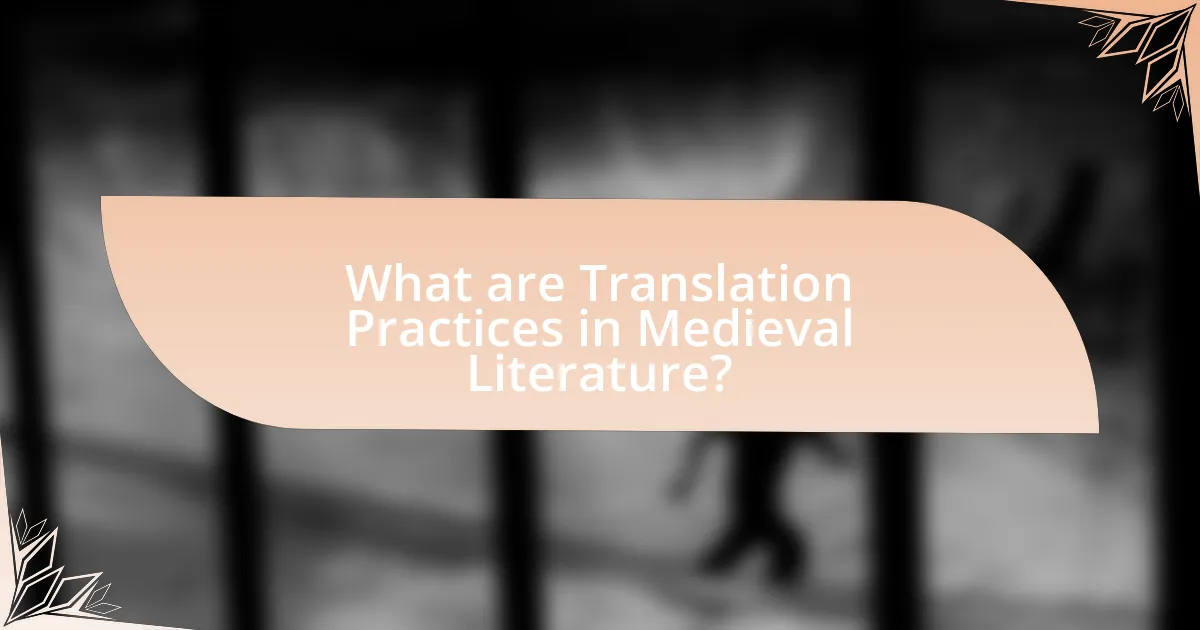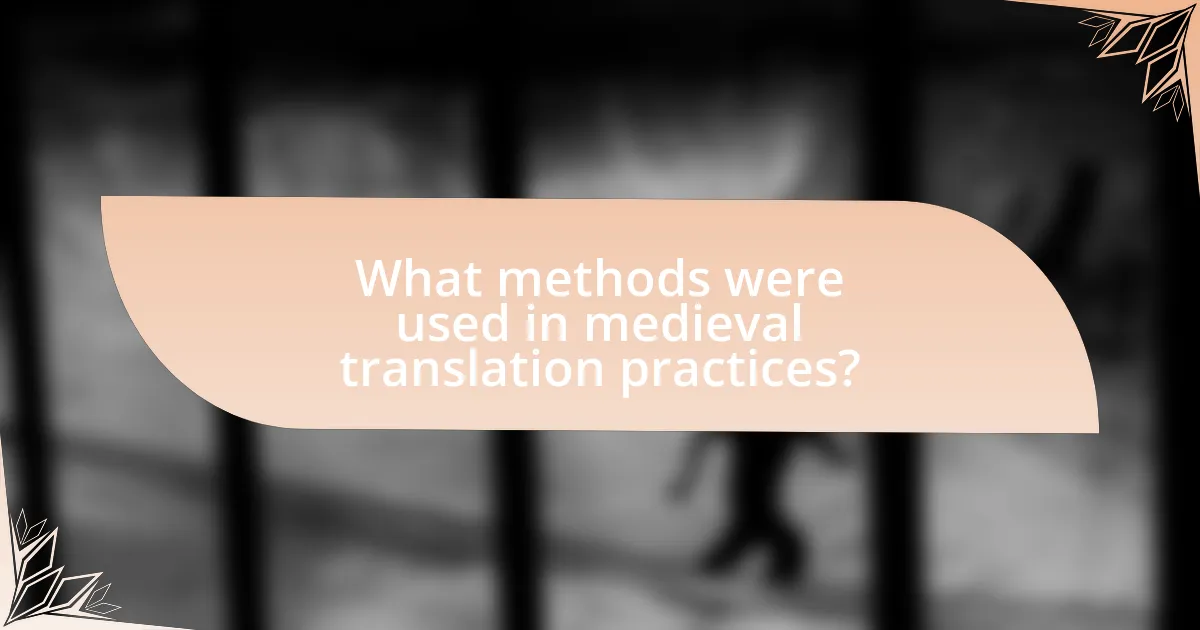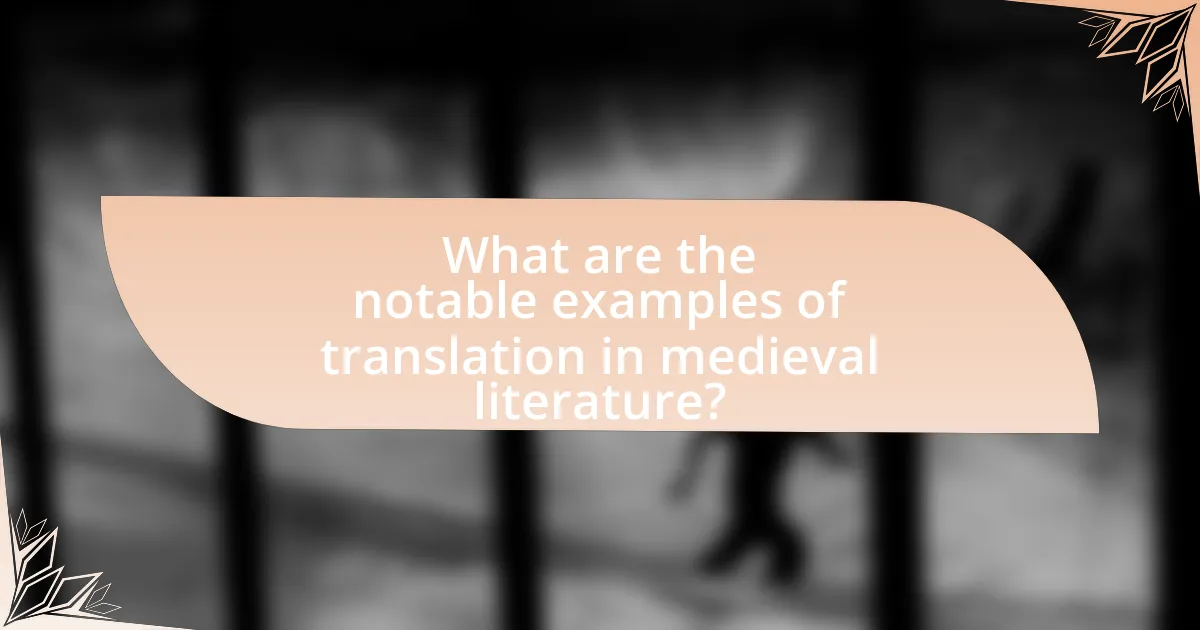Translation practices in medieval literature refer to the methods and approaches used to adapt texts from one language to another, facilitating access for diverse audiences. These practices included direct translation, paraphrasing, and cultural adaptation, significantly influencing the dissemination of literature and knowledge across linguistic boundaries. Key languages involved were Latin, Greek, Arabic, and various vernaculars, with notable translations such as the Latin Vulgate Bible and works by Geoffrey Chaucer and Dante Alighieri. The article explores how cultural exchanges shaped these practices, the challenges translators faced, and the lasting impact of medieval translation on modern literature and translation methodologies.

What are Translation Practices in Medieval Literature?
Translation practices in medieval literature involved the adaptation and interpretation of texts from one language to another, primarily to make them accessible to different linguistic and cultural audiences. These practices included direct translation, paraphrasing, and the incorporation of local idioms and cultural references to resonate with the target audience. For instance, the translation of religious texts, such as the Bible, was crucial for spreading Christianity, with notable examples like the Latin Vulgate and the Old English translation of the Gospels. Additionally, translators often took creative liberties, reflecting their own cultural contexts and the needs of their audiences, which is evidenced by the variations found in texts like “The Canterbury Tales” and “The Divine Comedy.”
How did translation influence the dissemination of literature in the medieval period?
Translation significantly influenced the dissemination of literature in the medieval period by making texts accessible across linguistic and cultural boundaries. This process allowed works originally written in Latin, Arabic, and Greek to reach wider audiences in vernacular languages, thereby increasing literacy and cultural exchange. For instance, the translation of classical texts into Old French and Middle English during the 12th and 13th centuries facilitated the spread of knowledge and ideas, as seen in the works of translators like Robert of Chester and William Caxton. These translations not only preserved important literary and philosophical works but also inspired new literary forms and genres, contributing to the evolution of medieval literature.
What were the primary languages involved in medieval translations?
The primary languages involved in medieval translations were Latin, Greek, Arabic, and various vernacular languages such as Old French, Middle English, and Italian. Latin served as the dominant scholarly language, facilitating the translation of classical texts and religious works. Greek was crucial for translating philosophical and scientific texts, particularly during the Renaissance of the 12th century. Arabic contributed significantly to the transmission of knowledge, especially in mathematics, medicine, and astronomy, as many works were translated from Arabic into Latin. Vernacular languages emerged as important mediums for translation, making literature and knowledge accessible to a broader audience, exemplified by works like Dante’s “Divine Comedy” in Italian and Chaucer’s writings in Middle English.
How did cultural exchanges shape translation practices?
Cultural exchanges significantly shaped translation practices by facilitating the transfer of knowledge, language, and literary styles across different societies. During the medieval period, interactions through trade, conquests, and scholarly pursuits led to the translation of texts from Arabic, Greek, and Latin into vernacular languages, enriching the literary landscape. For instance, the translation movement in Spain during the 12th century, particularly in Toledo, resulted in the translation of numerous Arabic scientific and philosophical works into Latin, which profoundly influenced European thought and education. This cross-cultural dialogue not only expanded the vocabulary and techniques used in translation but also introduced new genres and themes, thereby transforming the practice of translation into a vital tool for cultural integration and intellectual exchange.
Why were translations important for medieval societies?
Translations were important for medieval societies because they facilitated the exchange of knowledge, culture, and ideas across linguistic and geographical boundaries. This process allowed for the preservation and dissemination of classical texts, religious scriptures, and scientific works, which were crucial for intellectual development during the Middle Ages. For instance, the translation of Greek and Arabic texts into Latin during the 12th century Renaissance significantly contributed to the revival of learning in Europe, enabling scholars to access advanced knowledge in philosophy, medicine, and mathematics. This cross-cultural interaction not only enriched European thought but also laid the groundwork for the eventual emergence of the Renaissance, demonstrating the vital role translations played in shaping medieval societies.
What role did translations play in the preservation of knowledge?
Translations played a crucial role in the preservation of knowledge by enabling the transfer of ideas, texts, and cultural practices across linguistic and geographical boundaries. During the medieval period, translations of classical works from Greek and Latin into Arabic and later into vernacular languages facilitated the retention and dissemination of philosophical, scientific, and literary knowledge. For instance, the translation movement in the House of Wisdom in Baghdad during the 8th to 10th centuries preserved many ancient texts that would have otherwise been lost, allowing scholars like Al-Khwarizmi to build upon this knowledge, which later influenced the European Renaissance. This process of translation not only safeguarded existing knowledge but also fostered intellectual exchange, ensuring that critical ideas were accessible to diverse audiences throughout history.
How did translations affect religious and philosophical texts?
Translations significantly influenced religious and philosophical texts by facilitating the dissemination of ideas across cultures and languages. For instance, the translation of the Bible into Latin (the Vulgate) in the late 4th century made Christian teachings accessible to a broader audience, shaping Western thought. Similarly, the translation of Greek philosophical works into Arabic during the Islamic Golden Age allowed for the preservation and expansion of ancient knowledge, which later re-entered Europe through Latin translations, impacting the Renaissance. These translation practices not only preserved texts but also introduced new interpretations and concepts, thereby transforming religious and philosophical discourse.

What methods were used in medieval translation practices?
Medieval translation practices primarily utilized methods such as literal translation, paraphrase, and adaptation. Literal translation involved a word-for-word rendering of texts, aiming to preserve the original structure and meaning. Paraphrase allowed translators to express ideas in a more accessible manner, often rephrasing sentences for clarity. Adaptation involved altering the content to fit the cultural context of the target audience, which was common in translating religious texts and literature. Historical evidence shows that translators like Geoffrey of Monmouth and William of Malmesbury employed these methods to make classical and religious works comprehensible to medieval audiences, thereby influencing the development of vernacular literature.
How did translators approach the source texts?
Translators approached source texts in medieval literature with a focus on fidelity to the original meaning and cultural context. They often employed methods such as literal translation, where they aimed to preserve the exact wording and structure, and dynamic equivalence, which prioritized conveying the intended message and emotional tone. Historical evidence shows that translators like Geoffrey of Monmouth and John of Trevisa adapted texts to resonate with their contemporary audiences, demonstrating a balance between accuracy and accessibility. This dual approach reflects the translators’ understanding of their role in bridging linguistic and cultural divides while maintaining the integrity of the original work.
What were the common strategies employed by medieval translators?
Medieval translators commonly employed strategies such as literal translation, adaptation, and paraphrasing. Literal translation involved a word-for-word rendering of texts, which was often used for religious and scholarly works to maintain fidelity to the original. Adaptation allowed translators to modify content to fit the cultural context of the target audience, making texts more relatable. Paraphrasing involved rewording passages to clarify meaning while preserving the original intent, which was particularly useful in translating complex philosophical or scientific texts. These strategies reflect the translators’ goals of accessibility and comprehension for their audiences, as evidenced by the widespread use of vernacular languages in translations during the medieval period.
How did the translator’s background influence their work?
The translator’s background significantly influenced their work by shaping their linguistic choices, cultural interpretations, and understanding of the source material. For instance, a translator with a strong education in classical languages would likely employ more accurate and nuanced translations of texts, reflecting their familiarity with idiomatic expressions and historical context. Additionally, translators from diverse cultural backgrounds may infuse their translations with unique perspectives, thereby altering the tone and style to resonate with their target audience. This is evident in the works of translators like John of Trevisa, whose upbringing in a rural English community informed his translation of Latin texts, making them more accessible to the lay audience of his time. Such contextual factors underscore the importance of a translator’s background in determining the fidelity and creativity of their translations.
What challenges did translators face during the medieval period?
Translators during the medieval period faced significant challenges, primarily due to linguistic barriers, cultural differences, and limited access to source texts. Linguistic barriers arose from the diverse languages spoken across Europe, such as Latin, Old English, and various vernaculars, making accurate translation difficult. Cultural differences complicated the translation process, as translators had to navigate varying societal norms, idioms, and references that were not universally understood. Additionally, limited access to source texts restricted translators’ ability to reference original works, often resulting in incomplete or inaccurate translations. These challenges were compounded by the lack of standardized terminology and the influence of religious and political authorities, which could dictate the content and style of translations.
How did linguistic differences complicate translation efforts?
Linguistic differences complicated translation efforts by creating challenges in conveying meaning accurately across languages. Variations in grammar, syntax, and vocabulary often led to misinterpretations or loss of nuance in translated texts. For instance, medieval translators faced difficulties when translating idiomatic expressions or culturally specific references that lacked direct equivalents in the target language, resulting in translations that could misrepresent the original intent. Historical examples include the translation of Latin texts into vernacular languages, where the absence of certain terms in the target language necessitated the use of approximations or adaptations, further complicating the fidelity of the translation.
What were the ethical considerations in translating texts?
Ethical considerations in translating texts include fidelity to the original meaning, cultural sensitivity, and the potential impact on the target audience. Translators must ensure that the essence and intent of the source text are preserved while being mindful of cultural nuances that may affect interpretation. For instance, mistranslation can lead to misrepresentation of cultural values, as seen in the translation of religious texts where doctrinal accuracy is paramount. Additionally, ethical translation practices require transparency about the translator’s choices and potential biases, as these can influence how the text is received.

What are the notable examples of translation in medieval literature?
Notable examples of translation in medieval literature include the Latin Vulgate Bible, translated by St. Jerome in the late 4th century, which became the standard biblical text for the Western Christian Church. Another significant example is “The Canterbury Tales” by Geoffrey Chaucer, which drew upon various French and Latin sources, showcasing the influence of translation on English literature. Additionally, the “Divine Comedy” by Dante Alighieri, originally written in Italian, has been translated into numerous languages, reflecting its widespread impact. These translations not only preserved but also transformed literary works, making them accessible to broader audiences and influencing subsequent literary traditions.
Which texts were most frequently translated during the medieval era?
The texts most frequently translated during the medieval era included the Bible, particularly the Latin Vulgate, and classical works by authors such as Aristotle and Cicero. The Bible was translated into various vernacular languages to make it accessible to a broader audience, with notable translations like the Wycliffe Bible in the late 14th century. Additionally, Aristotle’s works were translated from Greek to Latin, significantly influencing medieval philosophy and education. These translations were essential for the dissemination of religious and philosophical ideas throughout Europe during this period.
What impact did the translation of “The Divine Comedy” have on literature?
The translation of “The Divine Comedy” significantly impacted literature by making Dante Alighieri’s work accessible to a broader audience, thereby influencing various literary movements and styles. This accessibility allowed for the dissemination of its themes, such as morality, redemption, and the human experience, which resonated with writers across different cultures and eras. Notably, translations into languages like English and French in the 19th century sparked interest in Italian literature and inspired authors such as T.S. Eliot and Ezra Pound, who incorporated its elements into their own works. The translation process also contributed to the evolution of poetic forms and narrative techniques, as translators adapted Dante’s intricate structure and allegorical depth to fit their linguistic contexts, thus enriching the literary landscape.
How did the translation of “The Canterbury Tales” influence English literature?
The translation of “The Canterbury Tales” significantly influenced English literature by popularizing the use of the English vernacular in literary works. Geoffrey Chaucer’s decision to write in Middle English, rather than Latin or French, made literature more accessible to the general populace, thereby expanding the audience for literary texts. This shift encouraged subsequent authors to adopt English as their primary language for storytelling, fostering a rich tradition of English literature that included works by writers such as John Milton and William Shakespeare. The impact of Chaucer’s translation efforts is evident in the evolution of English literary forms and the establishment of a national literary identity during the late medieval period.
What legacy did medieval translation practices leave on modern literature?
Medieval translation practices significantly influenced modern literature by establishing foundational techniques for translating texts across languages and cultures. These practices introduced concepts such as fidelity to the source text and the importance of cultural context, which are essential in contemporary translation theory. For instance, the translation of classical works during the medieval period, such as the Latin Vulgate Bible, emphasized the need for accuracy and accessibility, shaping how modern translators approach literary works. Additionally, the use of vernacular languages in translations during the medieval era laid the groundwork for the rise of national literatures, as seen in the works of Dante and Chaucer, which continue to impact literary expression today.
How do contemporary translation practices reflect medieval methods?
Contemporary translation practices reflect medieval methods through the emphasis on fidelity to source texts and the use of collaborative translation processes. In medieval times, translators often worked closely with authors or scholars to ensure that the nuances of the original language were preserved, a practice that continues today in professional translation settings where translators consult with subject matter experts. Additionally, the medieval focus on translating texts for specific audiences, such as religious or scholarly communities, mirrors contemporary practices where translations are tailored to meet the cultural and contextual needs of modern readers. This alignment is evident in the way contemporary translators prioritize cultural adaptation and contextual relevance, similar to how medieval translators navigated linguistic and cultural barriers to convey meaning accurately.
What lessons can modern translators learn from medieval practices?
Modern translators can learn the importance of contextual understanding and cultural sensitivity from medieval practices. Medieval translators often engaged deeply with the source material, ensuring that they not only translated words but also conveyed the cultural and historical context of the texts. For instance, figures like St. Jerome, who translated the Bible into Latin, emphasized the need to understand the original language and culture to produce an accurate and meaningful translation. This approach highlights the necessity for contemporary translators to immerse themselves in the source culture and context to achieve fidelity and resonance in their translations.
What best practices can be derived from studying medieval translation practices?
Best practices derived from studying medieval translation practices include the emphasis on fidelity to the source text, the importance of cultural context, and the use of collaborative translation efforts. Fidelity to the source text was crucial, as translators aimed to preserve the original meaning and nuances, evident in works like the Latin translations of Aristotle, which maintained philosophical integrity. Understanding cultural context allowed translators to adapt texts for their audience, as seen in the translation of religious texts that incorporated local customs and language. Collaborative efforts, such as those in monastic communities, enhanced the quality and accuracy of translations, demonstrating that teamwork can lead to more nuanced interpretations. These practices highlight the significance of accuracy, cultural sensitivity, and collaboration in translation.